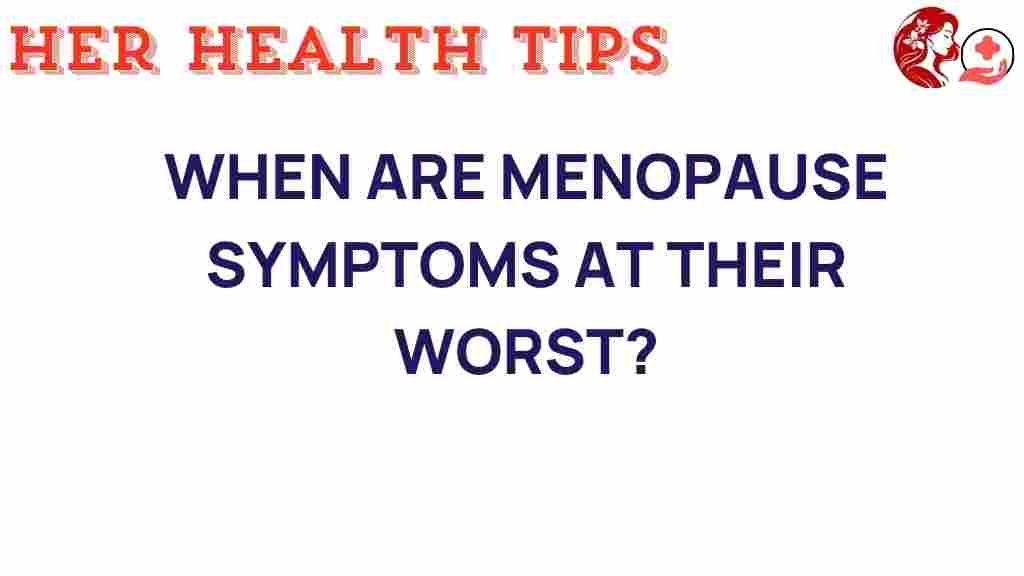Unraveling the Mystery: When Are Menopause Symptoms Most Intense?
Menopause is a natural phase in a woman’s life, marking the end of her reproductive years. While it is a significant transition, many women experience a variety of symptoms that can impact their quality of life. Understanding when these menopause symptoms are most intense can help women better prepare for this change. In this article, we will explore the various symptoms associated with menopause, the intensity of these symptoms during different stages, and effective treatment options to enhance women’s health.
Understanding Menopause and Its Symptoms
Menopause typically occurs between the ages of 45 and 55, with the average age being around 51. It is characterized by a decline in reproductive hormones, primarily estrogen and progesterone, leading to various physical and emotional changes. The symptoms of menopause can vary widely among women, both in type and intensity.
Some common menopause symptoms include:
- Hot flashes
- Night sweats
- Vaginal dryness
- Sleep disturbances
- Mood swings
- Weight gain
- Decreased libido
- Memory issues
These symptoms can significantly affect a woman’s quality of life. It’s essential to recognize that while menopause is a natural process, the intensity of symptoms can differ greatly from one individual to another.
The Stages of Menopause
Menopause is divided into three stages: perimenopause, menopause, and postmenopause. Each stage presents its own set of symptoms and varying intensity.
1. Perimenopause
Perimenopause is the transitional period leading up to menopause, which can last several years. During this stage, women may experience fluctuations in estrogen levels, leading to irregular menstrual cycles and heightened symptoms. The intensity of menopause symptoms can peak during this stage due to hormonal changes.
2. Menopause
Menopause is officially diagnosed when a woman has not had a menstrual period for 12 consecutive months. At this stage, the body experiences a significant drop in estrogen levels, which can lead to the most intense symptoms, especially hot flashes and night sweats. The intensity of these symptoms can vary but is often reported to be more severe during the first few years following menopause.
3. Postmenopause
Postmenopause refers to the years following menopause. While some symptoms may subside, others, such as vaginal dryness and changes in libido, may persist. The intensity of menopause symptoms generally decreases during this stage, but some women continue to experience discomfort.
Factors Influencing Symptom Intensity
Several factors can influence the intensity of menopause symptoms, including:
- Age: Younger women entering menopause may experience more severe symptoms.
- Genetics: Family history can play a role in symptom severity.
- Health Status: Pre-existing health conditions can exacerbate symptoms.
- Lifestyle: Diet, exercise, and stress levels can impact symptom intensity.
Step-by-Step Process to Manage Menopause Symptoms
Managing menopause symptoms effectively can improve overall wellness and quality of life. Here is a step-by-step process to help women navigate this transition:
Step 1: Educate Yourself
Understanding menopause and its symptoms can empower women to seek the appropriate treatment. Resources such as the North American Menopause Society provide valuable information about hormonal changes and symptom management.
Step 2: Consult a Healthcare Professional
It’s crucial to discuss symptoms with a healthcare provider who can recommend personalized treatment options. This might include:
- Hormone Replacement Therapy (HRT)
- Non-hormonal medications
- Vaginal moisturizers and lubricants
- Antidepressants for mood swings
Step 3: Adopt a Healthy Lifestyle
Making adjustments to diet and exercise can significantly impact the intensity of menopause symptoms:
- Diet: Incorporate a balanced diet rich in fruits, vegetables, whole grains, and healthy fats. Foods high in phytoestrogens, such as soy products, may help alleviate symptoms.
- Exercise: Regular physical activity can improve mood, promote better sleep, and help manage weight.
- Stress Management: Techniques such as yoga, meditation, and deep breathing can help mitigate stress, which can worsen symptoms.
Step 4: Explore Support Groups
Joining a support group can provide emotional support and practical advice from women going through similar experiences. Sharing stories can foster a sense of community and reduce feelings of isolation.
Step 5: Monitor Symptoms
Keeping track of symptoms can help identify patterns and triggers. This information can be valuable for discussions with healthcare providers about treatment options.
Troubleshooting Tips for Intense Menopause Symptoms
While menopause symptoms can be challenging, there are troubleshooting tips that can help alleviate some of the intensity:
- Hot Flashes: Dress in layers, stay cool with fans, and avoid triggers such as spicy foods and caffeine.
- Sleep Disturbances: Establish a calming bedtime routine, limit screen time before bed, and create a comfortable sleep environment.
- Mood Swings: Engage in regular physical activity, practice mindfulness, and consider counseling if needed.
- Vaginal Dryness: Use water-based lubricants during intimacy and consider vaginal estrogen therapy if recommended by a healthcare provider.
Conclusion: Embracing the Change
Menopause is a significant life transition that brings various symptoms, the intensity of which can differ greatly among women. By understanding when symptoms are likely to be most intense and how to manage them, women can take proactive steps to enhance their wellness and quality of life during this phase. Remember, seeking support and professional guidance is key to navigating menopause successfully.
For more information on women’s health during menopause and available treatment options, consider visiting Women’s Health Network. Embrace this change with confidence and prioritize your well-being!
This article is in the category Reproductive and created by HerHealthTips Team
